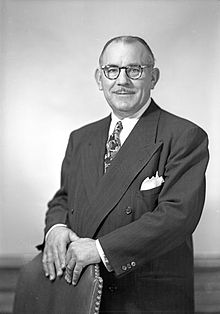Victor A. Meyers
| Victor A. Meyers | |
|---|---|

Meyers in 1951
|
|
| 10th Secretary of State of Washington | |
|
In office January 14, 1957 – January 11, 1965 |
|
| Preceded by | Earl Coe |
| Succeeded by | Lud Kramer |
| 11th Lieutenant Governor of Washington | |
|
In office January 9, 1933 – January 12, 1953 |
|
| Governor |
Clarence D. Martin Arthur B. Langlie Monrad C. Wallgren |
| Preceded by | John Arthur Gellatly |
| Succeeded by | Emmett T. Anderson |
| Personal details | |
| Born |
September 7, 1897 Little Falls, Minnesota, U.S. |
| Died | May 28, 1991 (aged 93) Seattle, Washington, U.S. |
| Political party | Democratic |
Victor Aloysius "Vic" Meyers (September 7, 1897 – May 28, 1991), known as "The Clown Prince of Politics" and "The Pagliacci of Politics", was a Seattle, Washington, jazz bandleader and Washington State Democratic Party politician. He served 20 years as the 11th Lt. Governor of Washington and an additional 8 years as the 10th Secretary of State of Washington.
Born in Little Falls, Minnesota, Meyers was the fifteenth of 16 children. His mother was a pianist; his father Morrison County treasurer. Meyers became a multi-instrumental musician, with drums as his first instrument.
His family moved to Oregon. In his teens, Meyers played drums professionally at a Seaside, Oregon hotel. At age 21 he put together a 10-piece band. In 1919 Meyers was given a 2-year contract to lead the house band at the Rose Room in Seattle’s Hotel Butler. The band enjoyed local success, and Butler's contract continued to be renewed. In 1923 Brunswick Records chose the group to record during the record company's West Coast field trip, the first records billed as "Vic Meyers Hotel Butler Orchestra". The band made further series of recordings for Brunswick the following year, and toured nationally before settling in Seattle, where he played on the radio. In 1927 his band first got a residency at the Trianon Ballroom in the Belltown/Denny Regrade area north of downtown Seattle's leading dance venue of the time, well known for its flouting of Prohibition.; the same year the band made the first of a series of recordings for Columbia Records which would continue through 1929. [2]
...
Wikipedia
